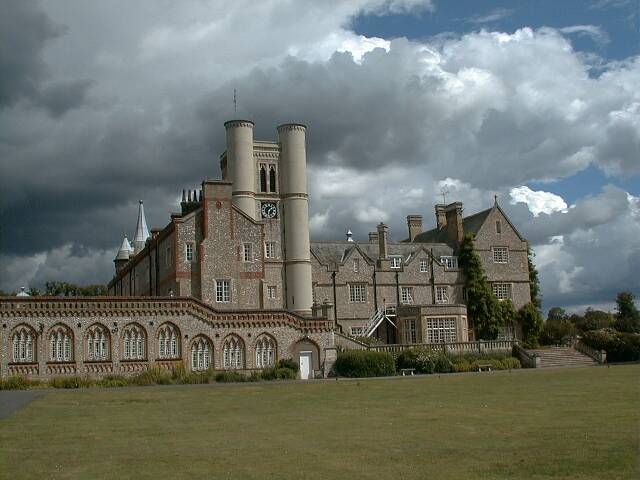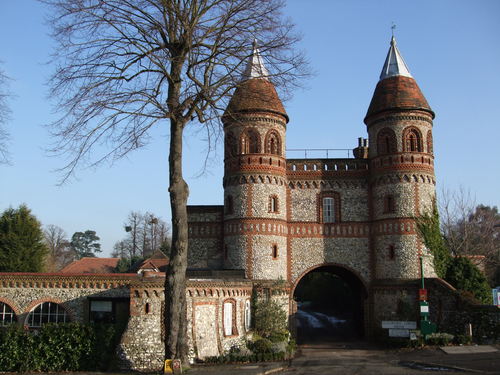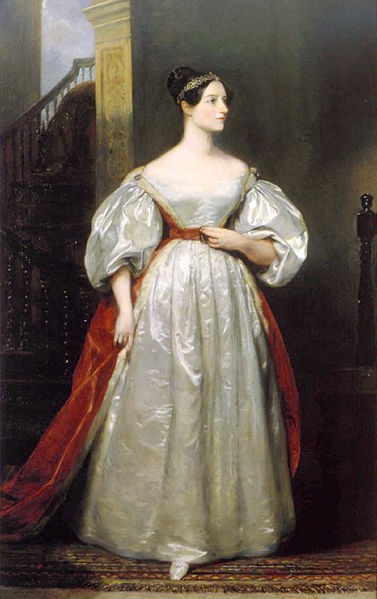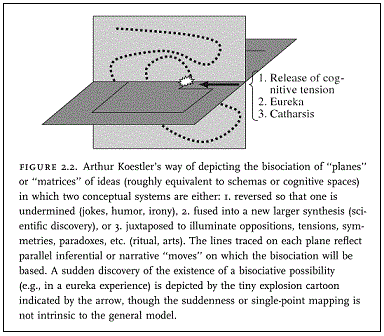In honor of Ada, Countess of Lovelace
[ by Charles Cameron — childhood memories, computer history, creative thinking, analogy, bead game ]
.
This menacing old pile, Horsley Towers — John Julius Norwich said of it in his Architecture of southern England, “The over-riding idiom seems to be vaguely Italianate Gothic, but in reality East Horsley is like nothing but itself, a grotesque Victorian Disneyland which has to be seen to be believed – and may not be even then” — was home to Ada, Countess of Lovelace, daughter of the poet Lord Byron.
Today is Ada Lovelace Day, and I have special reasons to honor her.
For one thing, I grew up inside these gate-towers, in the last little house before the Lovelace estate proper began, and certain features of the first fields on the way to the big pile were my childhood haunts, the old oak with its dark and mysterious hollow wound, the clovered grass and cow pats, the small mound for boyish climbing, the bramble bushes with their delicious blackberries…
*
But it is as a devotee of Hermann Hesse‘s great Bead Game that I want to celebrate Ada Lovelace today —
for she illustrates to perfection the importance of cross-disciplinary analogies in creativity.
*
Consider this diagram from Mark Turner‘s The artful mind: cognitive science and the riddle of human creativity, based on those in Arthur Koestler‘s The Act of Creation (eg those on pp 35 and 37):
Hesse proposes — in his Nobel-winning novel, the Glass Bead Game (aka Magister Ludi) the building of an architecture of ideas in which the great works of human culture are linked — bound together — by analogies between them.
Beginning players of his Game, he writes, learn “how to establish parallels, by means of the Game’s symbols, between a piece of classical music and the formula for some law of nature.” As I wrote elsewhere, on a more complex level, Hesse speaks of scholars proposing materials for inclusion in the Game Archives, and specifically mentions someone who had been studying “the rhythmic structure of Julius Caesar’s Latin and discovered the most striking congruences with the results of well-known studies of the intervals in Byzantine hymns”… Hesse couldn’t possibly have known about it when writing that particular sentence, of course, but there is actually a book by Jane-Marie Luecke, OSB, entitled Measuring Old English Rhythm: an Application of the Principles of Gregorian Chant Rhythm to the Meter of Beowulf, (Literary Monographs, vol 9, U. Wisconsin Press, 1978).
Hunh? So?
*
Consider what Ada, Countess of Lovelace hath wrought.
She perceived just such an analogy — comparing Charles Babbage‘s Analytical Engine with Jacquard‘s mechanical loom, and writing:
The Analytical Engine … weaves algebraic patterns, just as the Jacquard-loom weaves flowers and leaves.
That analogy between weaving and algebra was the great creative leap: from there to the adoption and adaptation of Jacquard’s punched card system in computation was the lesser step from insight to application.
And think about it: her mind moved unerringly between “art” and “science” — or more exactly, craft and mathematics — in 1843, to deliver a technological insight on which the mainframes of the 1970s still relied…
That, my friends, was a superb move in the spirit of the Glass Bead Game — and impossible without a well-furnished and agile mind.







October 8th, 2011 at 4:07 am
Between this, the Mad Axeman and the Beatniks, perhaps you ought to write some memoirs Charles!
October 8th, 2011 at 4:48 am
Ah, but where better than here, in dribs and drabs, and with odd musings on this, that and the apocalypse in between…
.
The big house was a pretty strange place, really. As I recall, there was a system of long, paved tunnels under the village — so that tradespeople could haul in their wares without being seen by their betters.
.
The house itself was designed by Sir Charles Barry, who also designed the (restored) Houses of Parliament. I’ll bet Michael Robinson could tell us a thing or two…
October 8th, 2011 at 2:15 pm
Charles,
.
The Kostler reference is intriguing—I’ve not heard of him. I wish the graphic were a little more descriptive. While I get the motivation to reduce/deduce via linear methods, my guess is the process involves multiple points/origins of synapses firing simultaneously to create something out of nothing on no more than an informed hunch.
.
One again, I’ll shamelessly plug Terrence Deacon’s work on emergence and cognition. He comes about as close as I’ve found to a reasonable explanation. Here is the closing sentence of his essay The Hierarchic Logic of Emergence: Untangling the Interdependence of Evolution and Self-Organization,
.
“Consciousness emerges as an incessant creation of something from nothing, a process continually transcending itself.”
October 8th, 2011 at 2:29 pm
Ada Lovelace is the pivotal figure, mostly mysteriously offstage, in Gibson and Sterling’s book The Difference Engine. If you have not read it, I believe you would enjoy it.
October 8th, 2011 at 5:01 pm
Do you think it was because she had "time" to think about it, which is useful in weaving?
October 8th, 2011 at 5:26 pm
Hi Larry:
.
In my view, based as it is in the influence of St Benedict, and confirmed by my encounters with other traditions, contemplation should precede action — so I tend to value time spent "nothing-doing" highly, and find that processes other than my own "doing something" get things done, somehow, inside me, which only emerge when I "take the time" to still my own activity.
.
What we have quite literally at our disposal is "the time of our lives" – but whether we ever "have the time of our lives" in our own lifetimes is another matter.
.
I’d imagine weaving would be among the more contemplative pursuits…
October 8th, 2011 at 5:31 pm
Lex:
.
Gibson and Stirling? wow! — I had a copy, but (and here’s the ironic part) didn’t "take the time" to read it…
.
It sounds as though I’ll have to "find time" one of these days.
October 8th, 2011 at 6:15 pm
Scott:
.
Here’s the beginning of Wikipedia’s piece on Koestler:
His book The Act of Creation tracks back (IMO) to Coleridge’s remarks about "the hooks and eyes" of memory — see The Road to Xanadu by Livingston Lowes for a fascinating, exhaustive and exhausting exploration of the ways in which odd phrases in Coleridge’s voluminous readings met and merged, the end results being such reveries as Kublai Khan and The Rime of the Ancient Mariner.
.
He’s not, in other words, working at the level of neuroscience, with synapses, but at the level of ideas, and specifically of ideas as embedded in what he variously terms frames of reference, associative contexts, types of logic, codes of behavior, and universes of discourse — before finally settling for matrices of thought and of behavior.
.
He quotes a joke from Freud, who quoted it in turn:
The assumption we’ll tend to have when hearing the beginning of the joke is that the Marquis will avenge the wrong done to him in his capacity as husband with something along the lines of a sword thrust to the throat or heart — one form of tit for tat. Our expectation is shattered as the joke proceeds, however, when he chooses another, unexpected framing of the situation, and delivers another kind of tit for tat: you do my job, okay, I’ll do yours!
.
Koestler traces this kind of switching of "frames" in humor, science and art: he calls it bisociation, "a double-minded, transitory state of unstable equilibrium where the balance of both emotion and thought is disturbed".
.
Another joke illustrates the principle:
As Koestler explains, here the coat is turned first metaphorically, then literally…
.
But I need to say more on this, and will have to leave it here for the moment. I’ll be getting back to you…
October 9th, 2011 at 12:01 am
Hi Charles,
.
Great response, and I look forward to hearing more.
.
I’ll be adding Koestler to the anti-library.
.
BTW, reflection is an incredibly powerful tool and one we should exercise often. I do my best “thinking” early in the morning, or when I’m doing strenuous labor outside. I’ve an enormous yard that needs constant attention—and I’m too cheap to hire someone to do it for me. With autumn in the air, I’ll hopefully get plenty of quality time reflecting and considering.
October 9th, 2011 at 9:58 am
The first publication of Ada Lovelace’s translation and notes, the loom references Charles refers to are in the ‘Notes,’( Babbage’s general ‘Analytical Engine’ was designed to have punched card input) :— Sketch of the Analytical Engine invented by Charles Babbage, Esq. By L. F. Menabrea of Turin, Officer of the Military Engineers [From the Bibliotheque Universelle de Geneve, No. 82 October 1842] in Taylor Richard ed. ‘Scientific Memoirs, selected from the transactions of Foreign Academies Of Science And Learned Societies, and from Foreign Journals. Volume III.’ London: 1843. Part XII, Article XXIX, pp. 666-731 [Introduction 666-69, Translation 669-690, Notes 691 -731]
.
There is another curious coincidence: though East Horsley was purchased circa 1840 Ada and her husband did not move in until 1846. From the time of her marriage in 1835 she lived at Ockham Park, in Victoria’s Coronation Honors in 1838 her husband acquired the subsidiary title of Viscount Ockham with the Earldom of Lovelace and, if period convention were followed in the household, her eldest son would have been alluded to as ‘Ockham.’ One wonders what she might have known of William of Ockham, whose work in logic long prefigured that of her mentor Willliam De Morgan and remains interesting and relevant today.
.
Lovelace seems to have been unusually preoccupied with bricks so much so that he broke caste and exhibited them under his own name at the Great Exhibition in 1851, and won the Gold Medal for brick making. He also enjoyed bridge building, constructing a series of 15 brick bridges to make it easier to move timber from woods to the sawmill, and even his own mausoleum, constructed 20 years prior to his death in 1893, is a personal brick composition “a summary of all the intricate details of decoration that he had devised to enhance his other buildings.”
October 9th, 2011 at 10:20 am
As you know I could go on for thousands of words on the subject of symbolism in the built environment.
.
The Palace of Westminster has a long and complex history over 26 years (it was never completed as designed) with Pugin placing the Gothic on Barry’s classical bones and responsible for all the interiors: Barry was an Italianate architect who would knock out the gothic vernacular in the early days when required, he later disowned his early gothic commissioners churches of the 1820’s and 30’s and wished them demolished. The central block of East Horsley as designed by Barry c 1839, and as would have been initially in Ada Lovelaces day, is clearly, from aerial photographs and plans, a classical villa in conception with English vernacular ‘skin’.
.
Apart from the concrete tower, much of what is shown in your photographs is the result of the work created, by Ada Lovelaces’s husband, William King-Noel (1st. Earl of Lovelace, 1805-1893), as a result of inspirations from his European traveling following the death of Ada in 1852. (I do not know of he traveled the restored castles of the Rhine, or the Hohenzoleran fantasies that inspired Ludwig of Bavaria to Neuschwanstein and therefore Disney at second hand). In 1865 he remarried Jane Crawford Jenkins and a good deal of the extended estate work is certainly post the second marriage.
.
These elaborate ‘Disneylands’ or pleasure complexes have a long complex history from Hadrian’s Villa onward, not least also in the Sabine Villa of Horace’s Odes. In England the landscape could be filled with complex meaning, most obviously at Stowe. But sprang to life in the C17th. with House & Garden being conceived as symbolic ‘Edens’ (Cf. Evelyn’s Elysium Brittanicum [John Evelyn’s ‘Elysium Britannicum’ and European Gardening&rsquo Mss, [online text – review by Keith Thomas — see also ‘The Garden, The Ark, the Tower and the Temple Biblical Metaphors of knowledge in early modern Europe’)
.
Even structures as seemingly inconsequential as a garden beehive could acquire endless refractions of theologico-political meaning when designed by the Royalist Wren after Pliny, with glass panels to show productive activity, the design published in Hartlib’s ‘The Reformed Commonwealth of Bees’ (1655). One was set up, circa 1658, in the fellows gardens of All Souls and another at Wadham by Bishop John Wilkins the cryptographer, later author of the famous ‘An Essay towards a Real Character and a Philosophical Language’ (1668))
.
Other than noting that this was the tradition in which he was working, in the absence of some written evidence it is difficult to know exactly what may have been in Lovelace’s mind when designing and ‘improving’ East Horsley – the incorporation of the entire surroundings, and distant village also, into the design scheme was not at all extraordinary, particularly post the Enclosure Acts, I could give a long list of similar examples.
.
[Continued]
October 9th, 2011 at 10:22 am
There are a few US examples of similar extensive built complexes which derive almost exclusively from a personal vision, notably the Bryn Athen ‘Historic District’ just outside Philadelphia which incorporates Glencairn built by Raymond Pitcairn (1885 -1966) without any architectural training between 1928-1939, its 11 stories and 100 rooms in an idiosyncratic personal expression of the robber baron Romanesque.
.
He started in 1913-19 with the adjacent cathedral decoration (the cathedral structure is by Ralph Adams Cram) and everything from the house itself to wall decoration, to shape of furniture and its decorative carving is governed by a distinctive personal symbolism derived by Raymond Pitcairn from what was essentially a ‘schismatic’ interpretation of Swedenborg’s visionary writings (The General Church of the New Jerusalem), financed by the Pitcairn fortune.
.
There are accompanying neighboring endowed denominational schools and a College – there are no ‘public’, ie non-denominational taxpayer funded schools in the Bryn Athen School District – the whole layout of Bryn Athen being laid out and landscaped for Raymond Pitcairn’s father by Charles Eliot, a partner in the Olmstead firm which designed New York’s central park.
.
No English landholder could wish for more of a ‘total’ environment for his tenants and laborers.
.
[continued]
October 9th, 2011 at 10:22 am
Multiple sets of passages to separate various classes of person are far from unknown, they are present in Barry’s work at Westminster and in other of his country houses;. to achieve the same separation and invisibility outside multiple paths, hedges and ha-ha’s or cuttings are the norm.
.
If there are tunnels and underground works at East Horsley this suggests serious eccentricity rather than simple snobbery: for example there are those at Welbeck, said to be of 15 miles in length, created by the 5th duke of Portland — in his later years a recluse who conducted every aspect of his life in writing and never invited anyone except his staff to the vast underground ballroom, 160 ft., and library of over 250 ft. in length; the series several miles of tunnels and rooms created c 1805 -1840 under Edge Hill by the Liverpool tobacco merchant Joseph Williamson – he also built houses described as ‘unorthodox and impractical.’; and most recently at a less elevated social and financial level William Lyttle, the ‘Mole Man’ of Hackney who has his own facebook page as a ‘Public Figure’.
.
One of the more bizarre modern tunnelers was the American academic lepidopterist and bigamist, Harrison Gray Dyer Jr., author of ‘Mosquitoes of North and Central America and the West Indies’ (1912-17) and the still standard ‘Mosquitoes of the Americas’ (1928), who conducted his hobby of tunneling under both of his houses in Washington — this is a schematic of the second set
October 9th, 2011 at 6:25 pm
Good grief – I grew up with corbelling, brattishing and guilloching all around me, and never knew it!
.
I suppose if your title is Lovelace, you may find a preoccupation with bricks and brickmaking afford you a suitable counterbalance…
.
Thanks, Michael – what an astounding journey through English eccentricity and countryside!
October 11th, 2011 at 7:47 am
Lovelace took to publishing reviews and papers at the end of the 1840’s. These are the texts of three relevant to his activities at Horsley Park:-
.
Ramée: architecture du moyen âge
[Manuel de l’historie générale de l Architecture vol II]
Prospective Review, April 1849
http://books.google.com/books?id=t-4HAAAAQAAJ&pg=PA1&source=gbs_toc_r&cad=4#v=twopage&q&f=false
Includes an extensive discussion of sacred geometry. Scan of a presentation copy of a repaginated separately published issue.
.
[Improvement of Landed Property]
The value of Landed Property Demonstrated, with Practical Deductions and Illustrations, tending especially to facilitate the Valuation of Estates. By Leyton Cooke, Esq., Land-surveyor. 1844.
‘Four Lectures on the Organization of Industry: being part of a course delivered before the University of Cambridge, in Easter Term,1844’. By T. C. Banfield, Esq.
http://books.google.com/books?id=4AQbAAAAYAAJ&dq
Westminster and Foreign Quarterly Review, October 1847 – January 1848, Vol XLVIII. pp [1]- 23.
.
On the Construction of a Collar Roof, with arched trusses of bent timber, at East Horsley Park. By the Right Honourable the Earl of Lovelace.
Minutes of the Proceedings of the Institution of Civil Engineers Volume 8, 1849, pp. 284 –286
http://books.google.com/books?id=aQ8FAAAAQAAJ&pg=PA282&lpg=PA282&dq
October 13th, 2011 at 8:09 am
Mr. Cameron,
.
Permit me to say something a little sexist: I have always been under the impression that all polymaths were (& still are) men.
.
But the daughter of Lord Byron was indeed a most unique anomaly (for want of a better word). Charles Babbage honours her with fine prose:
.
"Forget this world and all its troubles and if
possible its multitudinous Charlatans – every thing
in short but the Enchantress of Numbers."
.
The pleasures of growing up in an English countryside must evoke wondrous reminiscences, Mr. Robinson’s detailed accounts of "corbelling, brattishing and guilloching" adding much spice to the trip down memory lane.
October 14th, 2011 at 4:08 am
Hello, YT:
.
I’m not sure quite how one qualifies — was Hildegarde of Bingen a polymath? And I wonder about Diotima of Mantinea, who taught (or initiated?) Socrates, who taught Plato, who taught Aristotle, who taught Alexander of Macedon… Standing at the head of that particular line suggests she had quite a mind — but I don’t think we know much about her.
.
And besides, it’s hard to be much of a polymath until the disciplines separate themselves out, and universal knowledge becomes difficult if not impossible.
.
England? yes, many fond memories. And Michael Robinson’s scholarship adds greatly to the pleasure.
February 12th, 2013 at 10:07 pm
Charles,
I wonder if you know if this estate has any relation to my ancestry, I’m doing a bit of a family history hunt.
The relation I know of is Ann Lovelace, of Hertford born1611(?), with her the Gorsuch line crosses.
Any information you may have would be a delight to know.
Rebekah
February 13th, 2013 at 5:31 pm
I’m sorry, Rebekah, I know nothing of Lovelace’s antecedents. It would be fascinating if you discovered that you were in fact related.
July 24th, 2013 at 8:51 pm
Charles,
We now own the gate house and are wanting to restore some of its features. Could I ask when you lived here and if you have any recollection of the interior of the house and general layout at the time?
Best wishes
Andrea
July 25th, 2013 at 5:37 am
You mean the gate house itself? Unfortunately I never went inside. As I very vaguely recollect, though, there may have been a tiny shop of some sort on the outside of the gate house. Sorry I can’t be any more help than that..
July 25th, 2013 at 7:30 am
Yes, we live in the gate house. Thanks for replying. There was a shop there, but we are having problems finding out when various bits of the house were added, including when the shop was pulled down and the current extension added. It’s fascinating trying to dig into the history though!